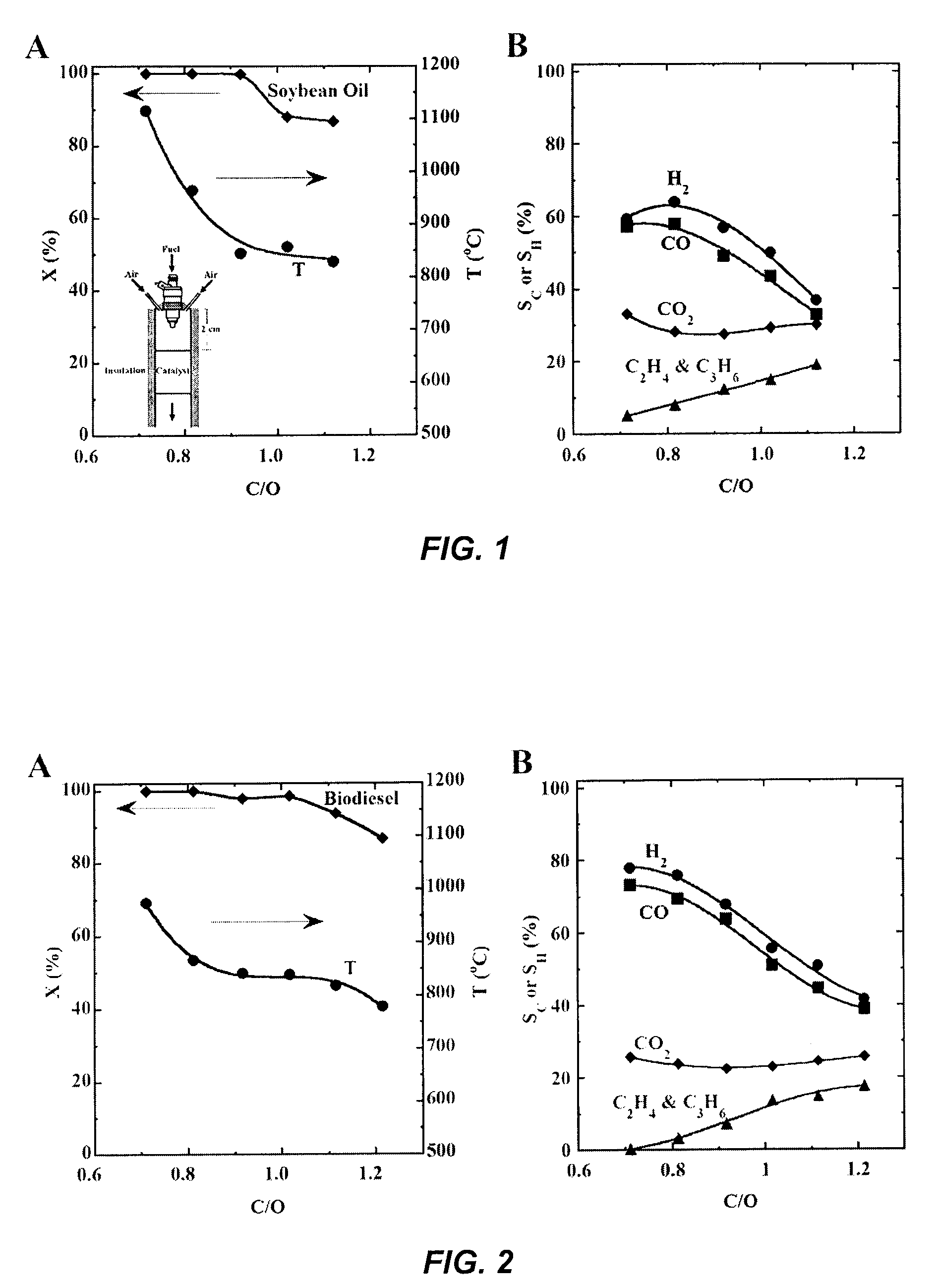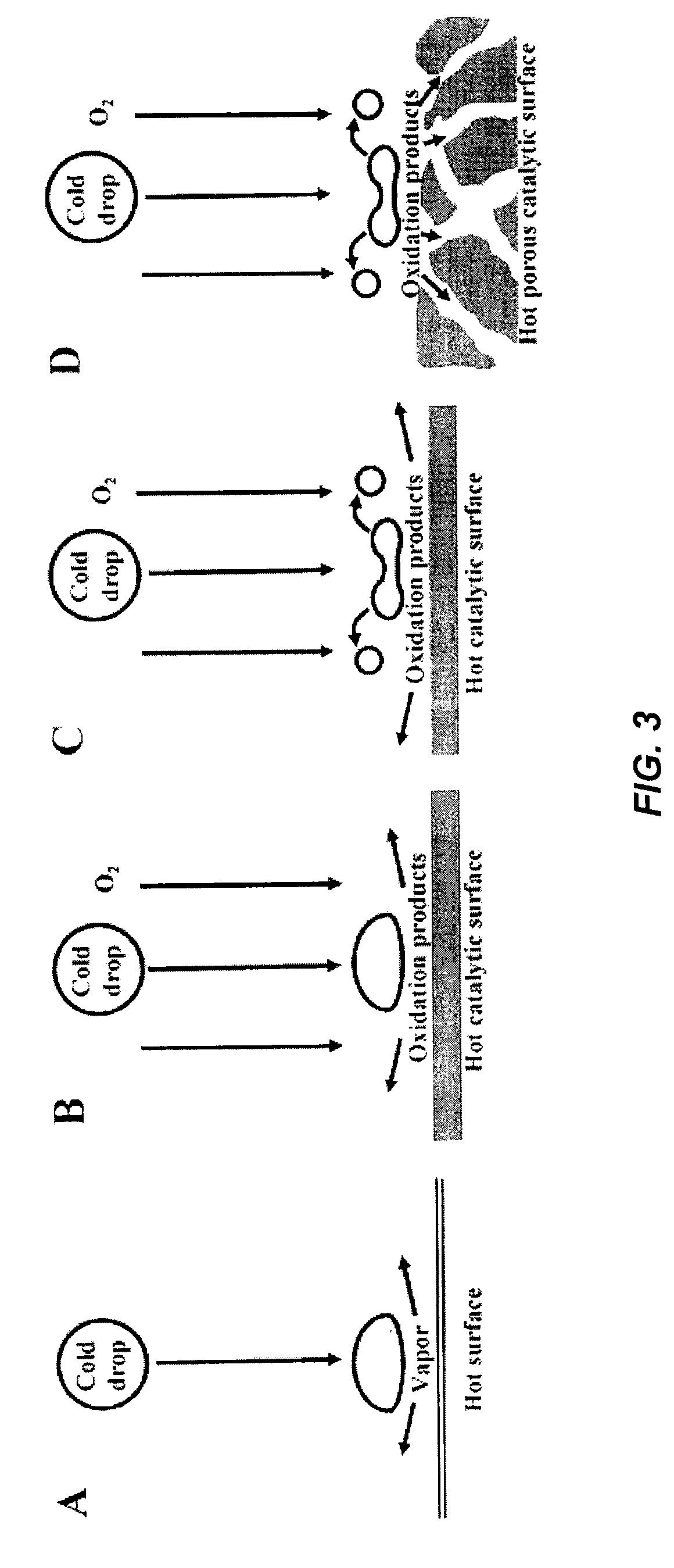Reactive flash volatilization of fluid fuels
a technology of fluid fuel and flash volatilization, which is applied in the direction of physical/chemical process catalysts, bulk chemical production, metal/metal-oxide/metal-hydroxide catalysts, etc., can solve the problems of complex, slow, and insufficiently simple current processes, and achieve easy scalable and sufficient catalytic methods. , the effect of high selectivity
- Summary
- Abstract
- Description
- Claims
- Application Information
AI Technical Summary
Benefits of technology
Problems solved by technology
Method used
Image
Examples
example 1
Reactive Flash Volatilization of Soy Oil
[0122]Results for the catalytic reactive flash volatilization of refined soy oil (the triglyceride of C18 and C16 fatty acids) as fuel are shown in FIG. 1A for conversion and temperature, and in FIG. 1B for selectivities to H2 and all carbon-containing products. The temperature 10 mm (millimeter) downstream from the front face, which can be generally cooler than the front face where oxidation reactions occur, decreased from 1100° C. (glowing bright orange) to 800° C. (dull red) as C / O increased from 0.8 to 1.2. The lower C / O limit can be set by thermal destruction of the catalyst (sintering of Rh), and the higher C / O limit can be set by carbon formation that shuts down the process.
[0123]This process was run for more than 20 hours on a given catalyst and it was repeated on several catalysts. In all cases, no deactivation was observed (4, to burn off this carbon.
[0124]The soy oil used was purchased from a local grocery store (“Crisco All Natural...
example 2
Reactive Flash Volatilization of Biodiesel
[0125]Results for an experiment similar to Example 1 were obtained with biodiesel. These results are shown in FIG. 2. Biodiesel (the methyl ester of the fatty acids from the triglyceride ester made by transesterification of soy oil) boils without decomposition at >300° C., so vaporization of biodiesel without carbon formation is possible. It has been previously shown (R. Subramanian, L. D. Schmidt, Angew. Chem. Int. Ed. 44, 302 (2005)) that biodiesel can be converted into H2 and CO, or into olefins, in a similar reactor system where the biodiesel was vaporized by heating the walls of the reactor above the catalyst to 300° C., and a heat shield-mixer was inserted between the vaporized fuel and the catalyst. In this Example, no external heat was added, so fuel and air were fed at room temperature. FIG. 2 shows that conversions and selectivities with biodiesel are similar to those seen when using nonvolatile soy oil directly.
example 3
Reactive Flash Volatilization of Aqueous Solutions
[0126]As another Example, a glucose-water solution was fed to the reactor through the fuel injector. Glucose (35% by weight) was dissolved in water. The solubility of glucose in water at 20° C. is 38% by weight. A steady-state operation was unable to be maintained under the instant conditions without adding CH4 along with the sugar, and the lowest CH4 level able to be maintained at C / O=0.8 was three carbon atoms from methane per carbon atom from glucose. Again, performance was comparable to that seen with soy oil or biodiesel, with >99% glucose conversion and approximately 70% H2 selectivity.
[0127]Little optimization of catalyst or conditions was attempted in Examples 1-3. Preheat in the volatilization zone or in the fuel injector can increase stability and performance. Additionally, smaller drop sizes can increase the range of operation.
[0128]The glucose (α-D-Glucose, anhydrous, 96%) was purchases from the Sigma-Aldrich Company, St....
PUM
| Property | Measurement | Unit |
|---|---|---|
| Temperature | aaaaa | aaaaa |
| Temperature | aaaaa | aaaaa |
| Temperature | aaaaa | aaaaa |
Abstract
Description
Claims
Application Information
 Login to View More
Login to View More - R&D
- Intellectual Property
- Life Sciences
- Materials
- Tech Scout
- Unparalleled Data Quality
- Higher Quality Content
- 60% Fewer Hallucinations
Browse by: Latest US Patents, China's latest patents, Technical Efficacy Thesaurus, Application Domain, Technology Topic, Popular Technical Reports.
© 2025 PatSnap. All rights reserved.Legal|Privacy policy|Modern Slavery Act Transparency Statement|Sitemap|About US| Contact US: help@patsnap.com



